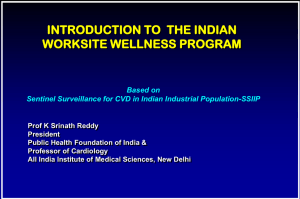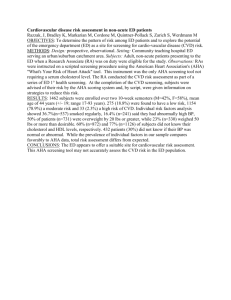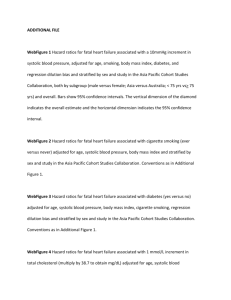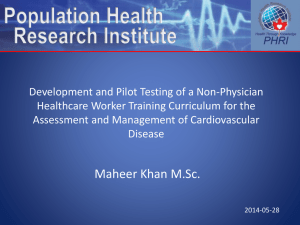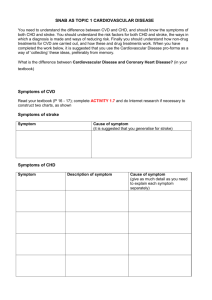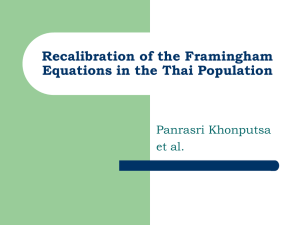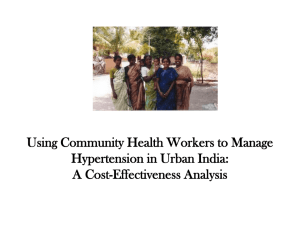Eleanor Kyoko Hagerman
advertisement
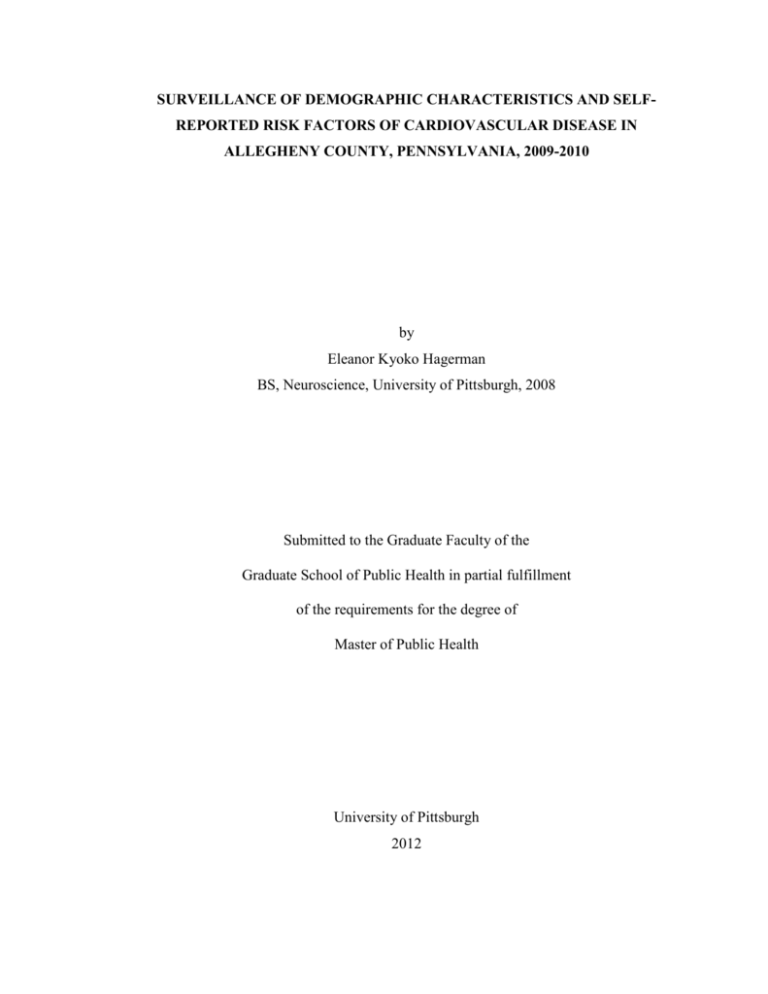
SURVEILLANCE OF DEMOGRAPHIC CHARACTERISTICS AND SELFREPORTED RISK FACTORS OF CARDIOVASCULAR DISEASE IN ALLEGHENY COUNTY, PENNSYLVANIA, 2009-2010 by Eleanor Kyoko Hagerman BS, Neuroscience, University of Pittsburgh, 2008 Submitted to the Graduate Faculty of the Graduate School of Public Health in partial fulfillment of the requirements for the degree of Master of Public Health University of Pittsburgh 2012 UNIVERSITY OF PITTSBURGH GRADUATE SCHOOL OF PUBLIC HEALTH This essay is submitted by Eleanor Kyoko Hagerman on January 7, 2013 and approved by: Essay Advisor: Rhobert Evans, PhD Associate Professor Epidemiology Graduate School of Public Health University of Pittsburgh Committee Member: Maria Brooks, PhD Associate Professor Epidemiology Graduate School of Public Health University of Pittsburgh Committee Member: Deborah Hutcheson, DCN, LDN, RD, CDE Assistant Professor Sports Medicine & Nutrition School of Health & Rehabilitation Sciences University of Pittsburgh ii Copyright © by Eleanor Kyoko Hagerman 2012 iii Rhobert Evans, PhD SURVEILLANCE OF DEMOGRAPHIC CHARACTERISTICS AND SELFREPORTED RISK FACTORS OF CARDIOVASCULAR DISEASE IN ALLEGHENY COUNTY, PENNSYLVANIA, 2009-2010 Eleanor Kyoko Hagerman, MPH University of Pittsburgh, 2012 Objectives: First, to analyze the prevalence of myocardial infarctions, coronary heart disease, and stroke in Allegheny County in 2002-2010 and compare these estimates in relation to those of Pennsylvania state and nationwide. Second, to obtain the prevalence of cardiovascular disease and cardiovascular disease risk factors among respondents with and without cardiovascular disease in Allegheny County for 2009-2010. Third, to detect differences in cardiovascular disease risk factor prevalence between males and females. Study Design: Data collected from the 5,442 respondents making up the Allegheny County Health Survey, a telephone survey modeled after the Center for Disease Control and Prevention (CDC) Behavioral Risk Factor Surveillance Survey (BRFSS), was analyzed. Methods: Prevalence of cardiovascular disease risk factors were obtained from chisquare analysis with corresponding confidence intervals and p-values. Results: Stroke prevalence was 1% higher in Allegheny County compared to Pennsylvania and nationwide data from 2002-2010. For the 2009-2010 year, the prevalence of cardiovascular disease in Allegheny County was 10%. The majority of adults with cardiovascular disease were older than 65 years of age (54%), had never iv obtained a college degree (84%), and earned less than $50,000 in annual income (76%). Overweight and obese adults made up 72% of all adults with cardiovascular disease, 32% had diabetes, 47% were heavy drinkers, 69% had hypertension, and 62% had high cholesterol. Males and females with cardiovascular disease had comparable diabetes (68% in females and 69% in males), high cholesterol (40% in females and 37% in males), and health care access (89% in females and 90% in males). Black females (17%) were more than twice as likely to have cardiovascular disease than black males (8%). More females with cardiovascular disease had never smoked before compared to males (39% versus 26%), were more likely to have hypertension (36% versus 27%), and were less likely to take aspirin daily or every other day (68% versus 77%). Conclusions: Cardiovascular disease is higher in Allegheny County than nationwide and is of public health significance. Public health interventions should be targeted to decrease traditional cardiovascular disease risk factors such as obesity, high cholesterol, and hypertension. However, gender-specific interventions should also be considered. v TABLE OF CONTENTS INTRODUCTION..............................................................................................................1 METHODS ........................................................................................................................ 1 Study Population .............................................................................................................................. 1 Outcome of Interest: Cardiovascular Disease .................................................................................. 2 Exposure Measurements .................................................................................................................. 2 Statistical Analysis ........................................................................................................................... 5 RESULTS .......................................................................................................................... 5 DISCUSSION .................................................................................................................. 18 BIBLIOGRAPHY ...........................................................................................................22 vi LIST OF TABLES TABLE 1. PREVALENCE OF SELF-REPORTED MYOCARDIAL INFARCTION IN ALLEGHENY COUNTY COMPARED TO PENNSYLVANIA AND NATIONWIDE DATA FROM 2002-2010. ......................... 8 TABLE 2. PREVALENCE OF SELF-REPORTED CORONARY HEART DISEASE OR ANGINA IN ALLEGHENY COUNTY COMPARED TO PENNSYLVANIA AND NATIONWIDE DATA FROM 20022010. ........................................................................................................................................ 8 TABLE 3. PREVALENCE OF SELF-REPORTED STROKE IN ALLEGHENY COUNTY COMPARED TO PENNSYLVANIA AND NATIONWIDE DATA FROM 2002-2010. ................................................. 8 TABLE 4. SAMPLE CHARACTERISTICS & POSSIBLE/KNOWN RISK FACTOR PREVALENCE FOR BRFSS RESPONDENTS & THE DISTRIBUTION OF SAMPLE CHARACTERISTICS & POSSIBLE/KNOWN RISK PREVALENCE OF THE CVD POPULATION ....................................... 10 TABLE 5. CVD RISK FACTOR PREVALENCE STRATIFIED BY GENDER & WITHIN-GENDER COMPARISON OF CVD VS. NON-CVD PREVALENCE DIFFERENCES ..................................... 14 TABLE 6. PREVALENCE ESTIMATE COMPARISON BETWEEN MALES WITH CVD & FEMALES WITH CVD ...................................................................................................................................... 16 vii LIST OF FIGURES FIGURE 1. PREVALENCE OF SELF-REPORTED MYOCARDIAL INFARCTION IN ALLEGHENY COUNTY COMPARED TO PENNSYLVANIA AND NATIONWIDE DATA FROM 2002-2010 .......................... 6 FIGURE 2. PREVALENCE OF SELF-REPORTED CORONARY HEART DISEASE OR ANGINA IN ALLEGHENY COUNTY COMPARED TO PENNSYLVANIA AND NATIONWIDE DATA FROM 20022010 ......................................................................................................................................... 7 FIGURE 3. PREVALENCE OF SELF-REPORTED STROKE IN ALLEGHENY COUNTY COMPARED TO PENNSYLVANIA AND NATIONWIDE DATA FROM 2002-2010 .................................................. 7 viii INTRODUCTION Although cardiovascular disease (CVD) mortality has been gradually decreasing in the United States from the 1960’s1, CVD remains the leading cause of death, affecting approximately 8.1% of the U.S. population2. Healthcare costs nation-wide pertaining to CVD are estimated to be more than $297.7 billion dollars per year, including direct and indirect costs. 2 Smoking, obesity, or alcohol consumption are well known risk factors for CVD and can be studied in relation to demographics such as social economic status, race, or gender to pinpoint areas that require public health interventions in a specific region. Data on estimated disease prevalence can be derived from surveys such as the National Health and Nutrition Examination Survey (NHANES) or the Behavioral Risk Factor Surveillance Survey (BRFSS). The overall objectives of this study were to use the Allegheny County BRFSS to provide general information about CVD in Allegheny County and to provide different points of possible interventions. To fulfill these aims, prevalence of myocardial infarctions, coronary heart disease, and stroke were analyzed in Allegheny County from 2002 to 2010; these values were then compared to Pennsylvania and nationwide BRFSS data. Additionally, demographic information and CVD risk factors were compared among adults with CVD and adults without CVD. Finally, as it is well known that CVD manifests itself differently in males and females12, prevalence estimates of risk factors for each gender were obtained and compared for statistical significance. METHODS Study Population The Allegheny County Health Survey is a behavior risk factor surveillance survey (BRFSS) of Allegheny County, Pennsylvania, modeled after the CDC’s BRFSS 1 questionnaire13. The survey was conducted via random-digit dialing telephone interviews of adults aged 18 years and older living in households. The Allegheny County Health Department (ACHD) collaborated with the University of Pittsburgh Graduate School of Public Health for the year of 2009-2010 in data collection, oversampling for these underserved populations. In total, 5,442 participants completed the survey. More details of the data sampling methods are available from Allegheny County Health Department13. Outcome of Interest: Cardiovascular Disease Cardiovascular disease was defined as an affirmative response to one or more of the following questions on the Allegheny County Health Survey. “Has a doctor, nurse, or other health professional ever told you that you had any of the following” such as 1) a heart attack /myocardial infarction 2) angina/coronary heart disease 3) a stroke. Respondents who answered negatively to all three questions were determined as not having CVD. Any refusals or “don’t know” answers were excluded from the data. The prevalence of CVD in Allegheny County was compared to Pennsylvania BRFSS data and nationwide BRFSS data found on the online CDC database. Exposure Measurements General demographic variables such as gender, age, education, household income, and race were assessed directly using the BRFSS survey response. Race was categorized into non-Hispanic whites and non-Hispanic blacks and other. Due to the extremely small sample size of other races, data for individuals who were categorized as “other race” were not considered representative data, and the results are not shown in this paper. Information about respondent aspirin intake, hypertension, diabetes, and high cholesterol, came directly from ACHD BRFSS questions. Other exposure variables such as obesity, smoking, alcohol consumption (binge drinking and heavy drinking), healthcare access, life satisfaction, and physical activity, were derived according to the CDC classifications and codebook15. Details regarding exact classification methods of each variable are described below. The ACHD BRFSS collected limited 2 data on adverse childhood experiences and did not collect data on questions pertaining to parental divorce/separation or about incarceration of family members. Accordingly, the adverse childhood variable module did not include these aspects. BMI/Obesity Body mass index (BMI) measures were calculated using the ACHD BRFSS questions pertaining to height and weight. A BMI of more than 30 kg/m2 was classified as obese, overweight if between 25 kg/m2 to 30 kg/m2, in the normal range with a BMI of 18.5 kg/m2 to 25 kg/m2, and underweight if the BMI was less than 18.5 kg/m2. Smoking Survey respondents who had not smoked at least 100 cigarettes in their lifetime were classified as never smokers, while those who had smoked at least 100 cigarettes in their lifetime and answered that they no longer smoked were classified as former smokers. Those who had smoked more than 100 cigarettes in their lifetime and still smoked some days were classified as someday smokers. Respondents who had smoked at least 100 cigarettes in their lifetime and still smoked every day were grouped as everyday smokers. Alcohol Consumption The two variables of interest for alcohol consumption were binge drinking and heavy drinking. A person was considered a binge drinker if they drank more than 5 drinks on one occasion in the past 30 days if they were male and more than 4 drinks on one occasion in the past 30 days if they were female. People were considered heavy drinkers if they consumed more than 2 drinks per day if male and more than 1 drink per day if female. Healthcare Access Respondents who reported having health care coverage such as health insurance, prepaid plans such as HMOs, or government plans, between the ages of 18 years to 64 years were considered to have healthcare access. Respondents between the ages of 3 18 years to 64 years without any health care coverage were reported as not having healthcare access. Life Satisfaction Respondents who reported being satisfied or very satisfied to the question, “in general, how satisfied are you with your life,” were classified as satisfied, while the not satisfied or very dissatisfied were grouped as dissatisfied. Respondents who were not sure or refused to answer were excluded from the data analysis. Adverse Child Experience The CDC defines adverse childhood experiences as verbal, physical, sexual, or household/family dysfunctions. Categories of parental separation/divorce or incarcerated family members, included in the CDC family dysfunction category, were not included in the ACHD survey and therefore not included in the adverse child experience variable. Respondents answering “not sure or don’t know” to any of the adverse childhood questions were defined as a negative response. Respondents who answered “sometimes,” “often,” or “very often” to the question of experiencing parental/adult swearing, insults, or put-downs were categorized as having experienced verbal abuse. Respondents who answered “once or twice,” “sometimes,” “often,” or “very often” to the question of how many times a parent or adult had hit, beaten, kicked, or physically injured the respondent, were categorized as experiencing physical abuse. Sexual abuse was defined as an affirmative to the question of whether an adult/parent had “touch[ed] you sexually or try to make you touch them sexually.” Household dysfunction was defined as having anyone living in the home who was “depressed, mentally ill, or suicidal” while growing up or living with anyone who was a “problem drinker, alcoholic, or drug user.” Respondents who experienced any of these variables of verbal, physical, sexual abuse, and household dysfunction were classified as positive for adverse childhood experience. 4 Statistical Analysis Prevalence estimates and 95% confidence intervals (CIs) for demographic variables and possible (and known) CVD risk factors were computed. All analyses accounted for design weights based on the probability of selection and post-stratification weights. The Rao-Scott chi square test was used for comparison between prevalence of different distributions by CVD disease status or by sex. All data analysis used SAS 9.3. RESULTS Characteristics of the sample study population in Allegheny County from the period of 2009-2010 are outlined, including the oversampling of minorities and lower income areas. Of the 5442 respondents, 67% were women, 19 % were non-Hispanic black, and 33% of the population were older than 65 years of age. Approximately 62% had an annual income lower than $50 thousand dollars, 9% of study subjects had less than a high school education, and 44% were employed (28% retired). Overall, 16% were everyday smokers, 56% were heavy drinkers, and 14% were binge drinkers. Health related data of the population indicate that 64% of the study population was classified as either overweight or obese, 41% had been diagnosed as having high cholesterol, 41% had been diagnosed with hypertension, and 13% of the sample population had been diagnosed with diabetes. Nearly 13% of the sample population had cardiovascular disease based on survey responses. After application of design weights and implementation of post-stratification weights, the following prevalence estimates were obtained for the Allegheny County population. Demographic data showed that 50% were women, 10% were nonHispanic black, and about 22% were older than 65 years of age. Fifty-seven percent made less than $50 thousand dollars annually and 50% were employed (about 20% retired). Eighteen percent were everyday smokers, 60% were heavy drinkers, and 19% were binge drinkers. Eleven percent of the population had been diagnosed as diabetic, 62% were overweight or obese, 38% had been diagnosed with high 5 cholesterol, and 33% had been diagnosed with hypertension. The prevalence of cardiovascular disease in Allegheny County was estimated to be 10%. Table 1 through Table 3 compares the prevalence of myocardial infarction, coronary heart disease or angina, and stroke, from 2002 to 2010 for Allegheny County, Pennsylvania, and nationwide. From 2002 to 2009, Table 1 shows that Allegheny County myocardial infarction prevalence remained constant at 5%, higher than the nationwide mean of 4.2% and also higher than Pennsylvania’s mean of 4.7%. Coronary heart disease or angina prevalence in Allegheny County shown in Table 2/Figure 2, followed the slightly decreasing trend displayed by Pennsylvania state and the nation. From 2002 to 2009, Allegheny County coronary heart disease prevalence remained comparable from 5% in 2002 to 4.7% in 2009. In 2009, the prevalence of coronary heart disease in Allegheny County was nearly identical to the Pennsylvania state, but 1% higher than the national average. Table 3 shows that the prevalence of ischemia or stroke increased from 3% to 3.6% in 2009, a prevalence estimate slightly greater than both the state prevalence of 2.5% and the national average of 2.4% in 2009. Taking into account the 95% confidence intervals for MI, CHD, and stroke, we see that of the incremental fluctuations of prevalence estimates in Allegheny County and Pennsylvania, only stroke is significantly higher in Allegheny County compared to Pennsylvania in 2009. Finally, it is of note that in 2010, Pennsylvania’s ischemia prevalence increased to 3.4%, while the national average marginally increased to 2.7% from 2.4% compared to the previous year (Table 3/Figure 3). Prevalence of Self-Reported Myocardial Infarction in Allegheny County compared to Pennsylvania & Nationwide Data 6 Prevalence (%) 5.5 5 4.5 Allegheny County Pennsylvania 4 3.5 Nationwide 3 2.5 2010 2009 2008 2007 2006 2005 2004 2003 2002 2 Year Figure 1. Prevalence of Self-Reported Myocardial Infarction in Allegheny County compared to Pennsylvania and Nationwide Data from 2002-2010. 6 Prevalence of Self-Reported Coronary Heart Disease or Angina in Allegheny County compared to Pennsylvania & Nationwide Data 6 Prevalence (%) 5.5 5 4.5 Allegheny County Pennsylvania 4 3.5 Nationwide 3 2.5 2010 2009 2008 2007 2006 2005 2004 2003 2002 2 Year Figure 2. Prevalence of Self-Reported Coronary Heart Disease or Angina in Allegheny County compared to Pennsylvania and Nationwide Data from 2002-2010. Prevalence of Self-reported Stroke in Allegheny County compared to Pennsylvania & Nationwide Data 6 Prevalence (%) 5.5 5 Allegheny County Pennsylvania 4.5 4 3.5 Nationwide 3 2.5 2010 2009 2008 2007 2006 2005 2004 2003 2002 2 Year Figure 3. Prevalence of Self-Reported Stroke in Allegheny County compared to Pennsylvania and Nationwide Data from 2002-2010. . 7 Table 1. Prevalence of Self-Reported Myocardial Infarction in Allegheny County compared to Pennsylvania and Nationwide Data from 2002-2010. Allegheny County Pennsylvania Nationwide Year (%) CI (%) CI (%) CI 2002 5 NA 2003 2004 2005 4.6 4.1-5.1 4.0 NA 2006 4.7 4.1-5.3 4.1 NA 2007 4.4 3.8-5.0 4.2 NA 2008 5.3 4.8-5.8 4.2 NA 2009 5.1 4.5-5.7 4.6 4.1-5.1 4.0 NA 2010 4.7 4.2-5.1 4.2 NA Table 2. Prevalence of Self-Reported Coronary Heart Disease or Angina in Allegheny County compared to Pennsylvania and Nationwide Data from 2002-2010. Allegheny County Pennsylvania Nationwide Year (%) CI (%) CI (%) CI 2002 5 NA 2003 2004 2005 5.1 4.6-5.6 4.4 NA 2006 5.5 4.9-6.1 4.5 NA 2007 5.4 4.8-6.0 4.1 NA 2008 5.3 4.8-5.8 4.3 NA 2009 4.7 4.1-5.2 4.8 4.3-5.2 3.8 NA 2010 4.7 4.3-5.1 4.1 NA Table 3. Prevalence of Self-Reported Stroke in Allegheny County compared to Pennsylvania and Nationwide Data from 2002-2010. Allegheny County Pennsylvania Nationwide Year (%) CI (%) CI (%) CI 2002 3 NA 2003 2004 2005 2.5 2.2-2.8 2.6 NA 2006 2.8 2.3-3.3 2.6 NA 2007 3.3 2.7-3.9 2.6 NA 2008 2.6 2.3-2.9 2.6 NA 2009 3.6 3.1-4.1 2.5 2.1-2.8 2.4 NA 2010 3.4 3.0-3.8 2.7 NA 8 Table 4 shows the number of survey respondents with CVD (‘n’) and the CVD risk factor prevalence (‘prevalence %’) and distribution (‘distribution %’) in Allegheny County. The prevalence estimate shows the percentage of the population with CVD within each characteristic/risk factor, while the distribution describes the percentage of the CVD population that exhibits each characteristic/risk factor. Of the population with cardiovascular disease, about half were male and half were female. Males had a slightly higher prevalence of CVD at 10% versus the prevalence of CVD in females at 9%; however, the difference in CVD prevalence was not significant. Age groups most affected by CVD were persons aged 45 to 65 years of age and the age group older than 65 years of age. For persons 45 to 65 years of age, the CVD prevalence was 11%, while the CVD prevalence was 25% for the population older than 65 years of age. By education level, higher education levels exhibited lower prevalence of CVD. Of the population who had lower than a high school education, 16% had CVD, 14% of high school graduates had CVD, 9% with some college education had CVD, and 5% with a college degree or higher-level education had CVD. By race, non-Hispanic whites had a CVD prevalence of 10% versus the 11% CVD prevalence seen in non-Hispanic blacks; however, non-Hispanic blacks and non-Hispanic whites both had comparable prevalence estimates of cardiovascular disease, with overlapping confidence intervals. When comparing CVD risk factors (obesity, smoking, diabetes, hypertension, cholesterol, and alcohol consumption) in Allegheny County, the obese population made up the largest group afflicted with cardiovascular disease compared to the overweight group, or the normal weight group. Surveyed individuals who were underweight made up only 2% of the CVD population; however, 11% of underweight individuals had cardiovascular disease, which was comparable to the 14% with CVD among obese individuals. Former smokers made up the highest distribution with CVD at 16%, followed by someday smokers at 12%, 9% of everyday smokers, and 7% in never smokers. About 21% of the population reporting a hypertension diagnosis by a health professional had CVD, 29% of diabetics had CVD, and among people with high cholesterol, 19% had CVD. As for alcohol consumption in connection with CVD, binge drinkers had a CVD prevalence of 5% compared to the 11% CVD prevalence seen in 9 non-binge drinkers. Among heavy drinkers, 4% had CVD, while among non-heavy drinkers, 13% had CVD. Finally, of the population taking aspirin daily or every other day, 27% had CVD. Table 4. Sample Characteristics & Possible/Known Risk Factor Prevalence for BRFSS Respondents & the Distribution of Sample Characteristics & Possible/Known Risk Prevalence of the CVD Population Characteristic/Risk Factor n Prevalence % (95% CI) Distribution % (95% CI) Gender: Male Female Age: 18-29 30-44 45-64 65+ Education: < High School High School Some College College Degree Household Income: <$15 K $15K-$24.999 K $25K-$49.999K $50K-$74.999K $75K+ Race: White Black BMI: Underweight Normal Overweight Obese Smoking: Never smoker Former Smoker Someday Smoker Everyday Smoker Hypertension: No Hypertension Hypertension <Total Population> <CVD Population> 265 416 10.73 (9.37-12.10) 9.44 (8.47-10.41) 50.17(46.01-54.32) 49.83 (45.67-53.99) 5 24 238 413 0.98 (0-1.97) 2.51 (1.40-3.63) 10.52 (9.13-11.92) 24.65 (22.50-26.81) 1.69 (0.00-3.38) 6.04 (3.44-8.64) 38.62 (34.50-42.73) 53.65 (49.44-57.87) 77 293 172 135 15.96 (11.95-19.97) 13.70 (12.05-15.36) 8.90 (7.45-10.34) 5.35 (4.30-6.40) 14.63 (11.39-17.87) 43.54 (39.42-47.66) 25.70 (22.05-29.34) 16.13 (13.18-19.09) 153 175 198 69 86 16.68 (13.79-19.56) 14.44 (12.08-16.81) 10.38 (8.87-11.89) 6.57 (4.90-8.25) 5.38 (4.07-6.70) 21.02 (17.74-24.30) 25.41 (21.75-29.07) 29.87 (26.11-33.63) 10.37 (7.84-12.90) 13.33 (10.30-16.37) 530 137 10.21 (9.28-11.13) 10.96 (9.03-12.89) 84.88 (82.28-87.48) 12.67 (10.42-14.92) 14 176 222 243 11.49 (5.03-17.97) 7.21 (6.02-8.41) 9.97 (8.58-11.37) 13.75 (11.90-15.60) 2.07 (0.91-3.22) 25.82 (22.13-29.50) 33.32 (29.38-37.26) 38.80 (34.60-43.00) 234 305 42 99 6.81 (5.83-7.79) 15.68 (13.90-17.46) 11.56 (7.65-15.46) 9.30 (7.25-11.35) 32.63 (28.75-36.51) 44.81 (40.69-48.93) 5.93 (3.98-7.88) 16.63 (13.27-20.00) 196 485 4.70 (3.97-5.44) 20.79 (18.92-22.65) 31.23 (27.26-35.20) 68.77 (64.80-72.74) 10 Table 4 continued. Diabetes: No Diabetes Diabetes High Cholesterol: No High Cholesterol High Cholesterol Alcohol (Binge Drinking): Non-Binge Drinker Binge Drinker Alcohol (Heavy Drinker): Non-Heavy Drinkers Heavy Drinkers Aspirin Intake: No Aspirin Intake Daily/Every other day Aspirin Healthcare Access (ages 18-64): Healthcare Access No Healthcare Access Adverse Childhood Experience: No ACE ACE Life Satisfaction: Satisfaction No Satisfaction 457 224 7.72 (6.95-8.50) 28.85 (25.25-32.46) 68.44 (64.59-72.29) 31.56 (27.71-35.41) 255 396 7.44 (6.42-8.46) 19.34 (17.44-21.24) 38.21 (34.05-42.38) 61.79 (57.62-65.95) 594 48 11.18 (10.22-12.15) 4.97 (3.39-6.56) 90.31 (87.40-93.23) 9.69 (6.77-12.60) 388 293 13.36 (11.93-14.78) 3.88 (6.89-8.87) 52.64 (48.46-56.82) 47.36 (43.18-51.54) 188 493 3.83 (3.21-4.44) 26.75 (24.47-29.02) 27.74 (23.97-31.52) 72.26 (68.48-76.03) 240 26 0.43 (5.162-6.847) 1.28 (3.18-8.19) 89.22 (84.71-93.73) 10.78 (6.27-15.29) 260 298 8.73 (7.60-9.88) 11.11 (9.75-12.48) 43.33 (38.90-47.76) 56.67 (52.24-61.10) 551 77 9.43 (8.58-10.29) 15.97 (12.13-19.81) 86.47 (83.29-89.64) 13.53 (10.36-16.71) In Table 5, the data was stratified by gender to assess the possible difference in prevalence rates between males with CVD as compared to males without CVD and separately, females with CVD as compared to females without CVD. Table 5 shows the number of survey respondents with CVD (‘n’), the estimated proportion of CVD within each characteristic/risk factor (‘CVD Weighted %’), and denotes whether there was a significant difference between CVD versus non-CVD groups for each characteristic/risk factor group within each respective gender (‘p-value’). Table 6 shows the results of comparing the prevalence of demographic and risk factors between males with CVD and females with CVD and assesses the significance of the differences between the two groups. In more detail, Table 6 shows the number of survey respondents with CVD (‘n’), the estimated proportion of CVD in males within each risk 11 factor (‘Male CVD Weighted %’), the estimated proportion of CVD in females within each risk factor (‘Female CVD Weighted %’), and the significance between CVD in males versus CVD in females for each characteristic/risk factor group. In Table 5, the prevalence of CVD differs by age for both males and females, with the prevalence of CVD in 45 to 64 year olds half as high as those in the above 65 years of age (11% in 45-64 years of age versus 25% in 65 years of age and older). The prevalence of CVD among the defined age groups did not differ significantly between males and females (Table 6, 45-64 years of age: 12% males, 9% females; 65 years of age and older: 30% males, 21% females; p-value 0.163), although the data indicates that a slightly higher proportion of males have CVD than females from 45 years of age and above. For both men and women, CVD prevalence was significantly greater in people who had less education than some college (Table 5, less than high school: 13% males, 18% females; high school: 14% males, 13% females) and in those who earned less than $50 thousand dollars per year in income (Table 5, less than $15K: 15% males, 18% females; $15-24.999K: 16% males, 13% females; $25K-49.999: 12% males, 9% females). Males and females had significantly different CVD prevalence rates by education and income levels (Table 6, p=0.0039 for education, p=0.0002 for income). Females with a college degree had the lowest prevalence of CVD at 4%, where as in males, the difference in CVD prevalence did not differ significantly whether they had some college or a college degree (Table 5, some college: 10% males; college degree: 7% males). With regards to income, as shown in Table 6, more females earning less than $15 thousand dollars annually had CVD compared to males (Table 6, less than $15K: 15% males, 18% females; p-value: <0.0001). Females had lower CVD prevalence when earning an annual income of $50 thousand with CVD prevalence at 4%, while males did not have a lower CVD prevalence until earning an income annually of more than $75 thousand. In Table 5, CVD prevalence was not statistically associated with race (non-Hispanic white or non-Hispanic black) among males (Table 5, white: 11%, black: 10%; p-value: 0.1259). However, non-Hispanic black females with CVD had a markedly higher 12 prevalence of CVD at 12% compared to non-Hispanic white females without CVD at 9% (Table 5, p-value: 0.0485), showing that non-Hispanic black women are disproportionately affected with CVD. Among males and females, individuals with high cholesterol, hypertension, and taking aspirin daily or every other day, were more likely to have cardiovascular disease. The prevalence of CVD among males with high cholesterol was 21% (Table 5; p<0.0001) and 18% in females with high cholesterol (Table 5; p<0.0001). As for aspirin intake, 29% of all male aspirin users have CVD (p<0.0001) and 24% of female aspirin users have CVD (p<0.0001) and males taking aspirin had a higher prevalence of CVD at 29% compared to CVD females at 24% (Table 6, p-value: 0.0229). Both genders had comparable prevalence estimates of CVD within corresponding cholesterol groups (Table 6, diagnosed high cholesterol: 21% males, 18% females; p-value: 0.4428). With regards to alcohol intake, male binge drinkers had a 5% CVD prevalence compared to 1% in females (Table 6, p<0.0291). A greater percentage of males who reported experiencing adverse childhood experiences (ACE) had CVD than females reporting ACE (Table 6, ACE: 12% males, 10% females; p-value: 0.0259). A greater percentage of women who reported feeling dissatisfied with life had CVD compared to their female counterparts without CVD (Table 5, no life satisfaction: 17% females with CVD; pvalue: <0.0001), although the difference in prevalence was not statistically significant between females and males (Table 6, p-value: 0.3793). 13 Table 5. CVD Risk Factor Prevalence Stratified by Gender & Within-Gender Comparison of CVD vs. Non-CVD Prevalence Differences Males Females CVD Weighted % (95 % n CVD Weighted % (95 % CI) p-value n CI) p-value Age 18-29 1 0.34 (0-1.01) 4 1.64 (0-3.53) 30-44 6 2.13 (0.36-3.91) 18 2.88 (1.52-4.24) 45-64 102 12.26 (9.88-14.64) 136 8.92 (7.38-10.47) 65+ 156 30.23 (26.17-34.30) <0.0001 257 21.03 (18.67-23.38) <0.0001 Education <High School 21 13.46 (7.29-19.62) 56 18.16 (12.94-23.37) High School 104 14.31 (11.46-17.16) 189 13.19 (11.29-15.09) Some College 61 9.81 (7.25-12.37) 111 8.17 (6.55-9.78) College Degree 77 7.14 (5.45-8.82) 0.0007 58 3.52 (2.26-4.77) <0.0001 Income <$15 K 37 14.81 (9.72-19.92) 116 17.87 (14.48-21.26) $15K-$24.999 K 56 16.33 (11.83-20.83) 119 13.12 (10.61-15.63) $25K-$49.999K 88 12.04 (9.46-14.62) 110 8.96 (7.21-10.71) $50K-$74.999K 38 9.19 (6.16-12.22) 31 4.07 (2.52-5.61) $75K+ 46 5.86 (3.98-7.73) <0.0001 40 4.81 (2.99-6.64) <0.0001 Race White 229 11.20 (9.68-12.73) 301 9.29 (8.19-10.38) Black 30 9.75 (6.20-13.30) 0.1259 107 11.67 (9.42-13.91) 0.0485 BMI Underweight 1 9.20 (0-26.39) 13 11.95 (4.97-18.94) Normal 58 7.01 (5.05-8.98) 118 7.36 (5.86-8.85) Overweight 109 10.51 (8.46-12.56) 113 9.28 (7.50-11.07) Obese 92 15.06 (11.91-18.20) 0.0002 151 12.52 (10.48-14.56) 0.0007 Healthcare Access (ages 18-64): Healthcare Access 105 13.81 (11.05-16.57) 140 5.45 (4.45-6.46) No Healthcare Access 160 9.37 (7.82-10.92) 0.5097 17 6.35 (3.08-9.61) 0.5869 14 Table 5 continued. Males n Smoking: Never smoker 74 Former Smoker 139 Someday Smoker 16 Everyday Smoker 36 Hypertension: No D- Hypertension 71 D-Hypertension 194 Diabetes: No D-Diabetes 186 Diabetes 79 High Cholesterol: No D-High Cholesterol 95 D-High Cholesterol 163 Alcohol (Binge Drinking): Non-Binge Drinker 217 Binge Drinker 31 Alcohol (Heavy Drinker): Non-Heavy Drinkers 105 Heavy Drinkers 160 Aspirin Intake: No Aspirin Intake 54 Daily/Every other day Aspirin 211 Adverse Childhood Experience: No ACE 88 ACE 128 Life Satisfaction: Satisfaction 224 No Satisfaction 23 p-value n Females CVD Weighted % (95 % CI) 6.28 (4.72-7.83) 17.46 (14.62-20.29) 13.17 (6.42-19.91) 9.72 (6.24-13.20) <0.0001 160 166 26 63 7.24 (5.99-8.48) 13.84 (11.71-15.97) 10.02 (5.89-14.15) 8.92 (6.6-11.22) <0.0001 4.47 (3.34-5.59) 22.34 (19.25-25.44) <0.0001 125 291 4.90 (3.95-5.86) 19.26 (17.13-21.38) <0.0001 8.28 (7.01-9.55) 30.47 (24.40-36.54) <0.0001 271 145 7.24 (6.31-8.17) 27.40 (23.26-31.54) <0.0001 8.11 (6.37-9.85) 21.14 (17.97-24.31) <0.0001 160 233 6.89 (5.69-8.09) 17.68 (15.47-19.90) <0.0001 12.60 (10.84-14.35) 5.13 (3.23-7.03) <0.0001 377 17 10.14 (9.07-11.21) 1.45 (1.83-7.53) 0.0099 13.81 (11.05-16.57) 9.37 (7.82-10.92) 0.0035 283 133 13.10 (11.50-14.69) 6.13 (4.96-7.31) <0.0001 3.46 (2.46-4.47) 29.31 (25.64-32.98) <0.0001 134 282 4.14 (3.39-4.89) 24.32 (21.57-27.07) <0.0001 8.59 (6.71-10.47) 11.89 (9.71-14.07) 0.0245 172 170 8.85 (7.49-10.20) 10.32 (8.67-11.97) 0.1736 10.27 (8.86-11.68) 14.88 (8.62-21.13) 0.1057 327 54 8.69 (7.67-9.70) 17.00 (12.43-21.56) <0.0001 CVD Weighted % (95 % CI) 15 p-value Table 6. Prevalence Estimate Comparison Between Males with CVD & Females with CVD n Age 18-29 1 30-44 6 45-64 102 65+ 156 Education <High School 21 High School 104 Some College 61 College Degree 77 Income <$15 K 37 $15K-$24.999 K 56 $25K-$49.999K 88 $50K-$74.999K 38 $75K+ 46 Race White 229 Black 30 BMI Underweight 1 Normal 58 Overweight 109 Obese 92 Healthcare Access (ages 18-64): Healthcare Access 105 No Healthcare Access 160 Males CVD Weighted % (95 % CI) n Females CVD Weighted % (95 % CI) 0.34 (0-1.01) 2.13 (0.36-3.91) 12.26 (9.88-14.64) 30.23 (26.17-34.30) 4 18 136 257 1.64 (0-3.53) 2.88 (1.52-4.24) 8.92 (7.38-10.47) 21.03 (18.67-23.38) 0.1637 13.46 (7.29-19.62) 14.31 (11.46-17.16) 9.81 (7.25-12.37) 7.14 (5.45-8.82) 56 189 111 58 18.16 (12.94-23.37) 13.19 (11.29-15.09) 8.17 (6.55-9.78) 3.52 (2.26-4.77) 0.0039 14.81 (9.72-19.92) 16.33 (11.83-20.83) 12.04 (9.46-14.62) 9.19 (6.16-12.22) 5.86 (3.98-7.73) 116 119 110 31 40 17.87 (14.48-21.26) 13.12 (10.61-15.63) 8.96 (7.21-10.71) 4.07 (2.52-5.61) 4.81 (2.99-6.64) 0.0002 11.20 (9.68-12.73) 9.75 (6.20-13.30) 301 107 9.29 (8.19-10.38) 11.67 (9.42-13.91) 0.0072 9.20 (0-26.39) 7.01 (5.05-8.98) 10.51 (8.46-12.56) 15.06 (11.91-18.20) 13 118 113 151 11.95 (4.97-18.94) 7.36 (5.86-8.85) 9.28 (7.50-11.07) 12.52 (10.48-14.56) 0.0011 13.81 (11.05-16.57) 9.37 (7.82-10.92) 140 17 5.45 (4.45-6.46) 6.35 (3.08-9.61) 0.851 16 p-value Table 6 continued. n Smoking: Never smoker 74 Former Smoker 139 Someday Smoker 16 Everyday Smoker 36 Hypertension: No D- Hypertension 71 D-Hypertension 194 Diabetes: No D-Diabetes 186 Diabetes 79 High Cholesterol: No D-High Cholesterol 95 D-High Cholesterol 163 Alcohol (Binge Drinking): Non-Binge Drinker 217 Binge Drinker 31 Alcohol (Heavy Drinker): Non-Heavy Drinkers 105 Heavy Drinkers 160 Aspirin Intake: No Aspirin Intake 54 Daily/Every other day Aspirin 211 Adverse Childhood Experience: No ACE 88 ACE 128 Life Satisfaction: Satisfaction 224 No Satisfaction 23 Males CVD Weighted % (95 % CI) n Females CVD Weighted % (95 % CI) 6.28 (4.72-7.83) 17.46 (14.62-20.29) 13.17 (6.42-19.91) 9.72 (6.24-13.20) 160 166 26 63 7.24 (5.99-8.48) 13.84 (11.71-15.97) 10.02 (5.89-14.15) 8.92 (6.6-11.22) 0.0128 4.47 (3.34-5.59) 22.34 (19.25-25.44) 125 291 4.90 (3.95-5.86) 19.26 (17.13-21.38) 0.0354 8.28 (7.01-9.55) 30.47 (24.40-36.54) 271 145 7.24 (6.31-8.17) 27.40 (23.26-31.54) 0.9523 8.11 (6.37-9.85) 21.14 (17.97-24.31) 160 233 6.89 (5.69-8.09) 17.68 (15.47-19.90) 0.4428 12.60 (10.84-14.35) 5.13 (3.23-7.03) 377 17 10.14 (9.07-11.21) 1.45 (1.83-7.53) 0.0291 13.81 (11.05-16.57) 9.37 (7.82-10.92) 283 133 13.10 (11.50-14.69) 6.13 (4.96-7.31) <0.0001 3.46 (2.46-4.47) 134 4.14 (3.39-4.89) 0.0229 29.31 (25.64-32.98) 282 24.32 (21.57-27.07) 8.59 (6.71-10.47) 11.89 (9.71-14.07) 172 170 8.85 (7.49-10.20) 10.32 (8.67-11.97) 0.0259 10.27 (8.86-11.68) 14.88 (8.62-21.13) 327 54 8.69 (7.67-9.70) 17.00 (12.43-21.56) 0.3793 17 p-value DISCUSSION The CVD data amassed from the Allegheny County Health Survey/BRFSS for 2009 indicates that Allegheny County has a prevalence of CVD at 10%, which is higher compared to the national average by 2%. The prevalence of myocardial infarctions and CHD in Allegheny County is comparable to national CVD estimates. However, stroke prevalence is higher than the national average by 1%. Although the seemingly slight differences in CVD and stroke prevalence estimates may be attributed to survey sampling error, it is likely that the difference in prevalence estimates are real. According to US Census data for 2011, in Allegheny County, 16.6% of the population is older than 65 years of age compared to 15.6% in Pennsylvania and 13.3% in the entire US population14. Additionally, Allegheny County has a higher prevalence of smoking at 23% compared to the 19.3% seen nationwide5 and 60% of Allegheny County are heavy alcoholic drinkers. Furthermore, according to data released by the Allegheny County Health Department, hypertension in Allegheny County increased significantly from 27% to 33% and diabetes significantly increased from 7% to 11% from 2002 to 200925. Increased age, smoking, alcohol, diabetes, and hypertension are among the well-known risk factors that would increase the likelihood of CVD and therefore increase CVD prevalence in Allegheny County survey data in 2009/201016, 18, 19, 26. Consistent with CVD survey results in other parts of the country, persons with CVD in Allegheny County were more likely to be in lower SES groups, have less than a college education, and to make less than $50,000 per year in income17. Persons with CVD were also more likely to be obese, have hypertension, diabetes, high cholesterol, high daily alcohol intake, and to have smoked at one point in their lives. Increased incidence of physical health morbidity and mortality has long been associated with lower income groups. Cardiovascular disease is not an exception to this association. Many studies have concluded that a lack of resources (such as food, education, or infrastructure) to manage health explains the association of low income and higher 18 disease prevalence28,30. A recent study found that in addition to lack of access to material resources, unhealthy behaviors also compounded CVD/diabetes mortality by more than 30%27. Specifically, physical inactivity and smoking were found to be the most influential behavioral risk factors in causing CVD mortality over BMI, diet, and alcohol intake27. Thus, while public health interventions targeted towards decreasing unhealthy behaviors such as sedentary lifestyles and smoking are essential, there are clearly multiple facets that must be addressed to decrease CVD in the population by more than 30%. One such facet may be the role of gender in cardiovascular disease. Ongoing research in the CVD field suggests that CVD differentially affects males and females12; therefore, prevalence estimates were analyzed in both genders. Both men and women with CVD had similar age ranges and had similar risk profiles such as availability of health care access, high cholesterol and diabetes. Men and women with CVD significantly varied in characteristics such as education level, income, race, BMI distributions, smoking, hypertension, alcohol intake, and aspirin intake. A much greater percentage of black women were afflicted with CVD (17% black women compared to 8% black men), which may be due to the high prevalence of obesity seen among black women regardless of educational level compared to black men31. More males with CVD had hypertension than females, smoked at one point in their lives, and almost doubled the female prevalence of daily alcohol intake in heavy drinking and binge drinking. Although a greater proportion of non-alcoholic drinkers (nonheavy drinkers and non-binge drinkers) had CVD in both men and women, it is likely that individuals with CVD altered their risky behaviors that contributed to CVD after being diagnosed with CVD. Another explanation is that alcohol intake is neither necessary nor sufficient in causing CVD. Since questions regarding pre-CVD onset and alcohol intake are not asked in the BRFSS survey, it cannot provide a comprehensive outlook on the role of alcohol intake in the development of CVD. A similar conjecture is made concerning CVD and aspirin intake in men and women. Although men and women who took aspirin had a greater prevalence of CVD compared to non-aspirin takers, it is probable that after CVD onset, persons began to 19 take aspirin to manage their cardiovascular disease and thus the higher prevalence of CVD in the aspirin-takers. However, overall, increased smoking and alcohol intake in men may explain the reason as to why at the same income level, male CVD prevalence does not correlate with the same CVD prevalence seen in females. The findings in this report reiterate the importance of well-known CVD risk factors, such as smoking, high cholesterol, obesity, diabetes, or alcohol intake, while highlighting the underlying health disparities caused by gender, SES, and education, in the occurrence of cardiovascular disease. Women with CVD were significantly more likely to make less than $50,000 per year in income, to have less than a college degree, and less likely to take aspirin for their CVD compared to men. Physiologically, men have a greater risk of CVD before 65 years of age; the risk of CVD in women exceeds the risk of CVD in men after 65 years of age22. Consequently, higher CVD prevalence reported by men compared to women aged 65 years and above may have been due to underreporting of CVD by women. Studies show that due to disparate CVD symptoms exhibited between men and women20,22,23 and lower CVD awareness among women24, CVD is often undetected in women both by healthcare providers and by women with CVD until the advanced stages of the disease21,22. Thus, to minimize CVD in the population, greater education on genderspecific CVD symptoms and risk should be targeted towards women, including the importance of medication intake (aspirin). However, as insinuated earlier in this paper, since there are multiple risk factors for CVD, public health interventions should also be multi-tiered. Educating women about gender-specific CVD symptoms alone will not be sufficient in the detection and reduction of CVD. Programs such as the Well-integrated Screening and Evaluation for Women Across the Nation (WISEWOMAN) funded by the CDC, provides lifestyle programs, medication, medical screenings, and risk factor counseling for low-income women, and have reported success in significantly reducing CVD risk factors in these women33. Such programs, expanded to include the entire community, would likely reduce CVD prevalence for the entire population. 20 As with other BRFSS studies, there were weaknesses in this study. Although the Allegheny County BRFSS provides useful population aggregate data, it is a crosssectional study and thus causality cannot be established between CVD and its risk factors. Further, the BRFSS is a telephone-based survey, which creates selection bias by only including households that have telephones. The study itself also had gaps in information in the prevalence estimates of MI, CHD, and stroke for different years; these gaps were caused by unavailable data, which hindered a more informative analysis. However, these results provide a snapshot of CVD in Allegheny County in 2009/2010 and are a stepping-stone to a more in depth risk factor analysis. In summary, as of 2009/2010, cardiovascular disease in Allegheny County remains a significant public health issue. Public health interventions should target CVD with multiple methods aimed to address different types of CVD risk factors, including addressing the population about gender-specific differences of CVD symptoms. 21 BIBLIOGRAPHY 1. Xu JQ, Kochanek KD, Murphy SL, Tejada-Vera B. Deaths: final data for 2007. Natl Vital Stat Rep 2009;58(19). 2. Roger, Veronique et al. AHA Statistical Update: Heart Disease and Stroke Statistics 2011. Circulation; 2011; 123 (e-18 to e-209). 3. CDC. Prevalence & Trends Data. Atlanta, GA: CDC; 2011. Available at http://www.cdc.gov/brfss/. Accessed June, July, August 2012. 4. CDC. Binge Drinking Fact Sheet. Atlanta, GA: CDC; 2010. Available at http://www.cdc.gov/alcohol/fact-sheets/binge-drinking.htm. Accessed August 2012. 5. CDC. Vital Signs: Adult Smoking in the US. Atlanta, GA: CDC; 2011. Available at http://www.cdc.gov/VitalSigns/AdultSmoking/index.html#StateInfo Accessed August 2012. 6. CDC . Application of Lower Sodium Intake Recommendations to Adults—United States 1999—2006. Atlanta, GA: CDC MMWR; 2009; 58 (11); 281-283. 7. CDC. Million Hearts: Strategies to Reduce Prevalence of Leading Cardiovascular Disease Risk Factors—United States, 2011. Atlanta, GA: CDC MMWR; 2011; 60 (36); 1248-1251. 8. Mayo Clinic. Stroke Risk Factors. http://www.mayoclinic.com/health/stroke/DS00150/DSECTION=risk-factors Accessed August 2012. 9. Mayo Clinic. Heart Attack Risk Factors. http://www.mayoclinic.com/health/heart-attack/DS00094/DSECTION=risk-factors Accessed August 2012. 10. Van Eenwyk, J et al. (2012). Comparison of Examination-Based and Self-Reported Risk Factors for Cardiovascular Disease, Washington State, 2006-2007. CDCPreventing Chronic Disease; 9:110321. 11. Shankar A, Syamala S, Kalidindi, S (2010). Insufficient Rest or Sleep and Its Relation to Cardiovascular Disease, Diabetes, and Obesity in a National, Multiethnic Sample. Plos One 5(11): e14189. 12. Mercuro G, Deidda M, Piras A, Dessalvi CC, Maffei S, Rosano GM. Gender determinants of cardiovascular risk factors and diseases. J Cardiovasc Med (Hagerstown). 2010 Mar;11(3):207-20. 13. Allegheny County Health Department. Behavioral Risk Factor Surveillance Survey. Available at http://www.achd.net/biostats/brfss.html. Accessed December 2012. 14. US Census Survey. State and County Quick Facts. http://quickfacts.census.gov/qfd/states/42/42003.html. 15. CDC. BRFSS Annual Survey Data: Survey Data & Documentation. http://www.cdc.gov/brfss/technical_infodata/surveydata/2009.htm. Accessed May 2012. 16. G Howard, LE Wagenknecht, GL Burke, A Diez-Roux. GW Evans, P McGovern, FJ Nieto, GS. Tell. Cigarette Smoking and Progression of Atherosclerosis. JAMA. 1998; 279(2): 119-124. 17. Abeyta IM, Tuitt NR, Byers TE, Sauaia A. Peer Reviewed Effect of Community Affluence on the Association Between Individual Socioeconomic Status and Cardiovascular Disease Risk Factors, Colorado, 2007–2008. Prev Chronic Dis. 2012; 9: E115. 22 18. Hahn RA, Heath GW, Change MH. Cardiovascular disease risk factors and preventive practices among adults—United States, 1994: a behavioral risk factor atlas. Behavioral Risk Factor Surveillance System State Coordinators. MMWR CDC Surveill Summ. 1998 Dec 11: 47 (5): 35-69. 19. Zhou QP, Remsburg R, Caufield K, Itote EW. Lifestyle behaviors, chronic diseases, and ratings of health between black and white adults with pre-diabetes. Dibetes Educ. 2012 Mar-Apr; 38(2): 219-28. 20. McSweeney JC, Cody M, O’Sullivan P, Elberson K, Moser DK, Garvin BJ. Women’s early warning symptoms of acute myocardial infarction. Circulation. 2003; 108: 2619-2623. 21. American Heart Association Special Report. “National Study of Physician Awareness and Adherence to Cardiovascular Disease Prevention Guidelines.” Circulation: Journal of the American Heart Association. 2005; 111: 499-510. 22. Dey S, Flather MD, Devlin GP, et al. Sex-related differences in the presentation, treatment, and outcomes among patients with acute coronary syndromes. Heart. 2009; 95: 20-26. 23. Rathore SS, Wang Y, Krumholz HM. Sex-based differences in the effect of digoxin for the treatment of heart failure. New England Journal of Medicine. 2002; 347(18): 1403-1411. 24. Mosca L, Mochari-Greensberger H, Dolor RJ, Newby LK, Robb KJ. Twelve-year Follow-up of American Women’s Awareness of Cardiovascular Disease Risk and Barriers of Heart Health. Circulation: Cardiovascular Quality and Outcomes. 2010; 3: 120-127. 25. Allegheny County Health Department. Results from the 2009-2010 Allegheny County Health Survey: Measuring the Health of Residents. 2012. 26. Geiss LS, Herman WH, Smith PJ. Mortality in non-insulin-dependent diabetes. In: National Diabetes Data Group, eds. Diabetes in America, 2nd ed. Washington, DC: National Diabetes Data Group, National Institute of Diabetes and Digestive Kidney Diseases, National Institutes of Health; 1995: 237-43. NIH publication no. 95-1468. 27. Jarvandi S, Yan Y, Schootman M. Income Disparity and risk of death: the importance of health behaviors and other mediating factors. Plos One. 1012; 7 (11): e49929. 28. Lynch JW, Smith GD, Kaplan GA, House JS. Income inequality and mortality: Importance to health of individual income, psychosocial environment, or material conditions. BMJ. 2000:320: 1200-1204. 29. Wilkinson RJ, Pickett KE. Income inequality and social dysfunction. Annu Rev Sociol. 2009. 35: 493-511. 30. Lantz PM, House JS, Lepkowski JM, Williams DR, Mero RP, Chen J. Socioeconomic factors, health behaviors, and mortality: results from a nationally representative prospective study of US adults. JAMA. 1998: 279 (21): 1703-8. 31. Mensah GA, Mokdad AH, Ford ES, Greenlund KJ, Croft JB. State of Disparities in Cardiovascular Health in the United States. Circulation. 2005; 111: 1233-1241. 23

